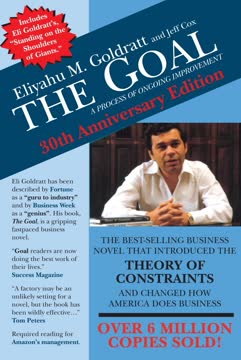Key Takeaways
1. Financial statements are the language of business
Accounting rules provide the mechanism by which business transactions and economic events get translated into numbers.
Financial fluency is essential. Understanding financial statements is crucial for managers at all levels. These documents provide a standardized way to communicate a company's financial health and performance. They consist of three main components: the balance sheet, income statement, and cash flow statement. Each offers a unique perspective on the company's financial situation.
Interpreting the numbers is key. Financial statements aren't just about numbers; they tell a story. Managers need to learn how to read between the lines, understand the assumptions behind the figures, and recognize potential areas of manipulation or misrepresentation. This skill allows them to make more informed decisions and contribute meaningfully to strategic discussions.
Continuous learning is necessary. The field of accounting and finance is constantly evolving, with new regulations and best practices emerging regularly. Managers should commit to ongoing education to stay current and maintain their financial literacy. This can involve reading financial news, attending workshops, or seeking mentorship from finance professionals within their organization.
2. Balance sheets reveal a company's financial position
Assets = Liabilities + Owners' Equity
Snapshot of financial health. The balance sheet provides a point-in-time view of a company's financial position. It shows what the company owns (assets), what it owes (liabilities), and the residual value belonging to shareholders (owners' equity). This fundamental equation must always be in balance, reflecting the dual nature of every financial transaction.
Asset composition matters. The types and proportions of assets a company holds can reveal much about its business model and strategy. Key categories include:
- Current assets (e.g., cash, inventory, accounts receivable)
- Non-current assets (e.g., property, plant, equipment, intangible assets)
Financing structure impacts risk. The liabilities and equity side of the balance sheet shows how the company has financed its assets. This includes:
- Short-term liabilities (e.g., accounts payable, short-term debt)
- Long-term liabilities (e.g., long-term debt, pension obligations)
- Shareholders' equity (e.g., retained earnings, paid-in capital)
The ratio of debt to equity, known as leverage, is a critical indicator of financial risk and flexibility.
3. Income statements measure profitability and performance
Revenue and growth are important, but they are not the whole story.
Beyond the bottom line. While net income is often called the "bottom line," focusing solely on this figure can be misleading. The income statement provides a detailed breakdown of how a company generates revenue and incurs expenses over a specific period. This allows managers to analyze various aspects of financial performance.
Key performance indicators. Important metrics derived from the income statement include:
- Gross profit margin: (Revenue - Cost of Goods Sold) / Revenue
- Operating margin: Operating Income / Revenue
- Net profit margin: Net Income / Revenue
These ratios help assess efficiency and profitability at different stages of operations.
Trend analysis is crucial. Comparing income statements over multiple periods can reveal important trends in revenue growth, cost management, and overall profitability. This information is vital for strategic planning and identifying areas for improvement or investment.
4. Cash flow statements track liquidity and cash management
Running out of cash is obviously not a good idea!
Cash is king. While profitability is important, a company's ability to generate and manage cash is critical for survival and growth. The cash flow statement reconciles the change in cash balance over a period, categorizing cash flows into three main activities:
- Operating activities
- Investing activities
- Financing activities
Operational efficiency. Cash flow from operations is a key indicator of a company's ability to generate cash from its core business activities. A consistently positive operating cash flow is generally a good sign, while negative cash flow may indicate problems with profitability or working capital management.
Investment and financing decisions. The investing and financing sections provide insights into how a company is deploying capital for growth and how it's financing those investments. This information is crucial for understanding a company's long-term strategy and financial health.
5. Profit margins and return ratios gauge operational efficiency
ROA = Profit Margin x Asset Turnover
Profitability in context. Profit margins alone don't tell the whole story of a company's performance. Return on Assets (ROA) and Return on Equity (ROE) provide a more comprehensive view by considering the resources used to generate those profits.
Components of performance. ROA can be broken down into two key components:
- Profit Margin: measures how much profit is generated from each dollar of sales
- Asset Turnover: indicates how efficiently assets are used to generate sales
This decomposition allows managers to identify whether improvements in profitability are coming from better pricing/cost management or more efficient asset utilization.
Capital structure impacts. ROE builds on ROA by considering the effects of leverage (debt financing). While higher leverage can amplify returns in good times, it also increases financial risk. Managers must balance the potential for higher returns against the increased vulnerability to economic downturns.
6. Cost behavior analysis informs strategic decision-making
Fixed costs are ones that do not change as activity levels, such as sales volume, fluctuate.
Understanding cost structures. Costs can be categorized as fixed or variable, and this distinction is crucial for decision-making. Fixed costs remain constant regardless of production volume, while variable costs change in proportion to output. This knowledge is essential for:
- Break-even analysis
- Pricing decisions
- Production planning
Contribution margin concept. The contribution margin (price minus variable costs) represents how much each unit of sales contributes to covering fixed costs and generating profit. This metric is valuable for:
- Evaluating product profitability
- Making decisions about special orders or discounts
- Optimizing product mix
Resource constraints matter. When resources (e.g., production capacity, skilled labor) are limited, managers must consider the contribution margin per unit of the constrained resource. This ensures that scarce resources are allocated to the most profitable products or activities.
7. Discounted cash flow analysis evaluates long-term investments
The present value of the project's stream of cash flows measures the economic value added or reduced by that project.
Time value of money. The core principle of discounted cash flow (DCF) analysis is that money received in the future is worth less than the same amount received today. This concept is crucial for evaluating investments with cash flows occurring over extended periods.
Key components of DCF analysis:
- Projected cash flows: Estimate future inflows and outflows
- Discount rate: Reflect the riskiness of the cash flows and opportunity cost of capital
- Terminal value: Account for cash flows beyond the projection period
Decision criteria. The net present value (NPV) of a project is the sum of its discounted cash flows. Projects with positive NPV add value to the company and should be pursued, while those with negative NPV destroy value. The internal rate of return (IRR) is another useful metric, representing the discount rate at which the NPV equals zero.
8. Financial literacy empowers managers to drive value creation
Financial statements are important sources of information in both looking forward to invest and looking backward to assess how you've done; managers skilled in accounting and finance have an advantage at each stage of the continuing cycle of "invest, assess, and revise."
Strategic decision-making. Financial literacy enables managers to:
- Evaluate investment opportunities
- Assess operational performance
- Contribute meaningfully to strategic discussions
- Communicate effectively with finance professionals and executives
Continuous improvement cycle. Understanding financial statements and analysis techniques allows managers to:
- Set meaningful performance targets
- Monitor progress against those targets
- Identify areas for improvement
- Develop and evaluate strategies for enhancing value creation
Broader perspective. Financial literacy helps managers see beyond their immediate area of responsibility and understand how their decisions impact the overall financial health of the organization. This holistic view promotes better alignment between departmental goals and company-wide objectives.
Last updated:
FAQ
What’s "Financial Literacy for Managers" by Richard A. Lambert about?
- Demystifying financial statements: The book explains how to read, interpret, and use financial statements—balance sheets, income statements, and cash flow statements—for better business decision-making.
- Manager-focused financial skills: It’s designed for managers and executives without a finance or accounting background, focusing on practical application rather than technical accounting rules.
- Strategic decision support: Lambert shows how financial literacy empowers managers to evaluate strategies, assess performance, and make informed investment decisions.
- Real-world examples: The book uses case studies from companies like PepsiCo, Krispy Kreme, and General Motors to illustrate key concepts.
Why should I read "Financial Literacy for Managers" by Richard A. Lambert?
- Essential business skill: Understanding finance and accounting is critical for managers to make informed decisions and contribute to strategic discussions.
- Bridges knowledge gaps: The book is tailored for non-financial managers, helping them overcome confusion or intimidation around financial data.
- Improves decision quality: By learning to interpret financial statements, managers can identify performance drivers, spot risks, and avoid costly mistakes.
- Enhances career value: Mastering these concepts makes managers more valuable to their organizations and better equipped for leadership roles.
What are the key takeaways of "Financial Literacy for Managers" by Richard A. Lambert?
- Financial statements are interconnected: Balance sheets, income statements, and cash flow statements each provide unique insights but must be understood together.
- Accounting is subjective: Financial statements involve estimates, judgments, and sometimes ambiguity, so managers must read between the lines.
- Profitability vs. liquidity: Net income and cash flow are not the same; both must be analyzed to assess a company’s health.
- Strategic use of financial data: Financial literacy enables managers to evaluate investments, allocate resources, and develop coherent business strategies.
How does Richard A. Lambert define and explain the three fundamental financial statements?
- Balance Sheet: Shows a snapshot of a company’s assets, liabilities, and owners’ equity at a specific point in time, revealing capital structure and risk.
- Income Statement: Measures revenues, expenses, and profitability over a period, helping managers understand how profits are generated.
- Cash Flow Statement: Tracks cash inflows and outflows, categorized into operating, investing, and financing activities, highlighting liquidity and funding sources.
- Interconnectedness: The book details how these statements relate, with changes in one often affecting the others.
What are the most important financial concepts and terms explained in "Financial Literacy for Managers"?
- Key terms demystified: Concepts like GAAP, NPV, ROA, EBITDA, WACC, leverage, and more are clearly defined and contextualized.
- Accounting vs. economic reality: The book explains differences between income and cash, depreciation and asset value, and why liabilities can be positive.
- Subjectivity and estimates: Lambert discusses how financial statements rely on estimates (e.g., asset valuation, revenue recognition) and why skepticism is necessary.
- Cost classifications: The book covers fixed vs. variable costs, direct vs. allocated costs, and the importance of understanding cost behavior.
How does "Financial Literacy for Managers" by Richard A. Lambert help managers use financial statements for better decision-making?
- Performance analysis: Managers learn to dissect financial statements to identify strengths, weaknesses, and areas needing attention.
- Strategic resource allocation: The book teaches how to decide which activities to expand, cut, or outsource based on financial data.
- Forecasting and planning: Understanding financials helps managers predict the impact of decisions on costs, revenues, and profitability.
- Benchmarking: The book emphasizes comparing performance over time, against budgets, and with competitors to guide strategy.
What is the difference between profitability and liquidity according to "Financial Literacy for Managers"?
- Profitability (Net Income): Reflects the value generated over a period, including non-cash items and future expectations.
- Liquidity (Cash Flow): Focuses on actual cash generated and used, critical for meeting obligations and funding operations.
- Distinct but related: The book explains why a company can be profitable but run out of cash, or have strong cash flow but weak profits.
- Managerial implications: Both measures are essential for assessing financial health and making sound business decisions.
How does Richard A. Lambert explain Return on Assets (ROA), Return on Equity (ROE), and leverage?
- ROA: Measures how effectively a company uses its assets to generate profits, independent of financing structure.
- ROE: Assesses the return generated for shareholders, factoring in the effects of debt (leverage).
- Leverage: Using debt can amplify returns (or losses) for equity holders; the book explains when and why leverage increases risk.
- Strategic use: Managers learn to balance asset efficiency, profit margins, and capital structure to optimize performance.
What practical advice does "Financial Literacy for Managers" offer for analyzing costs and making decisions?
- Cost behavior analysis: Distinguish between fixed and variable costs to predict how profits change with sales volume.
- Contribution margin and break-even: Use these tools to assess profitability, set prices, and evaluate special orders.
- Avoiding common pitfalls: The book warns against relying on unitized fixed costs, misallocating overhead, and considering sunk costs in decisions.
- Resource constraints: Managers are taught to allocate limited resources to maximize contribution margins per constraint.
How does "Financial Literacy for Managers" by Richard A. Lambert teach managers to evaluate investment opportunities?
- Discounted cash flow (DCF): The book provides a framework for calculating present value and internal rate of return (IRR) for investment decisions.
- Time value of money: Emphasizes why future cash flows must be discounted to compare alternatives accurately.
- Incorporating risk and inflation: Managers learn to adjust cash flow projections and discount rates for risk and changing prices.
- Sensitivity analysis: The book advocates testing assumptions under different scenarios to avoid over-optimism and improve decision quality.
What are the most common accounting and measurement issues highlighted in "Financial Literacy for Managers"?
- Asset valuation: Differences between historical cost and fair value, and the impact on reported performance.
- Revenue recognition: Timing and judgment in recognizing sales, especially with credit sales and bundled products.
- Expense allocation: How methods like FIFO, LIFO, and immediate expensing of R&D can distort profitability.
- Off-balance-sheet items: The book discusses how companies may hide liabilities and why managers must look beyond the numbers.
What are the best quotes from "Financial Literacy for Managers" by Richard A. Lambert and what do they mean?
- "Accounting is more like a language." — Emphasizes that understanding financial statements is about interpreting meaning, not just numbers.
- "Profitability (value generated) and liquidity (cash generated) are not the same thing." — Highlights the need to analyze both net income and cash flow for a complete financial picture.
- "Sunk costs are often not treated as irrelevant by the person who sunk them!" — Warns against letting past investments cloud current decision-making.
- "The numbers that come out are no more accurate than the quality of the assumptions that went into the analysis." — Stresses the importance of realistic forecasting and skepticism in financial planning.
- "It’s the synergies that arise from merging managerial experience with finance and accounting skills that can generate the most value to you and to your organization." — Underscores the book’s central message: financial literacy amplifies managerial effectiveness.
Review Summary
Financial Literacy for Managers receives mixed reviews, with an average rating of 3.57/5. Some readers find it informative and concise, praising its accessibility for financial novices. Others criticize it for lacking depth or new insights for those with basic business knowledge. The book covers financial statements and calculations, with several readers noting it's a quick read. Some suggest it's better suited for physical reading rather than audiobook format. Overall, opinions vary on its usefulness, with some finding it dry but informative, while others appreciate its simplicity and educational value.
Similar Books










Download PDF
Download EPUB
.epub digital book format is ideal for reading ebooks on phones, tablets, and e-readers.




